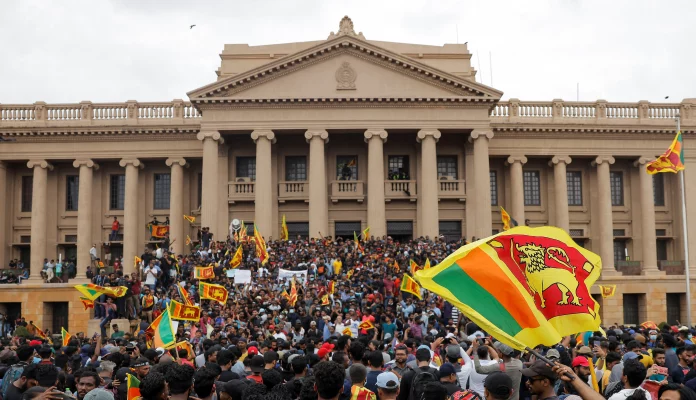This article is written by Lenita Thomas Kutty pursuing a Diploma in Intellectual Property, Media and Entertainment Laws from Lawsikho. This article discusses an analysis of the recent Sri Lankan crisis vis-à-vis sovereign domestic debt and what the Sri Lankan Government could do to restore the economy.
This article has been published by Sneha Mahawar.
Table of Contents
Introduction
In a country, financial matters are the backbone of its existence. A country with a good financial plan will always have a good GDP and grow economically and globally. For this reason, a balanced budget is necessary, when the accounting statement of the country is not balanced, it leads to several national and vital obstacles. Besides having a balanced budget, a county could have a budget deficit or a budget surplus. A budget deficit occurs when the expenses of the nation exceed the income of the nation. Inversely, a budget surplus is a situation where the income of the nation exceeds the expenses of the nation. The concerning situation is when the country faces a budget deficit, which means the country has to meet its expenses by either acquiring internal or external borrowing. Normally, countries do this by taking loans from domestic financial institutions inside the nation so that the money flow of the nation will be increased, and this has caused more money to be circulated. One major issue in the case of a budget deficit is that when the country faces a deficit, they might sometimes decide to print more money for an easier solution, but this can cause inflation and, in the long run, it can lead to recession.
The article talks about the issue of domestic debt and the most recent situation faced by Sri Lanka in 2022. It also contains a financial analysis of the Sri Lankan Government’s handling of the economic crisis that occurred in 2019. The article further goes into the issues faced by the Sri Lankan Government in the reconstruction of the economic crisis and the methods available for reconstruction. The article also explains the concerns that all the countries face due to the rise in national debt and why each of the nations should avoid it.
The concept of sovereign domestic debt
Domestic debt, or as it is commonly known, “internal debt,” occurs when a country’s budget deficits are met by a financial institution from within the country. Normally, a country uses these forms of money to create money flow and avoid domestic inflation.
Taking a look at India, the finances of the country are managed by the finance minister, who has a refined budget prepared annually for application and, in effect, a defined expected financial estimate along with it. When any government, be it a country or a nation, spends more on goods and services or transfer payments than it receives in tax revenue, it can be said that the government runs on a budget deficit. When a country is unable to meet its debt obligations, it has the possibility of acquiring funds for the financial year to use in order to meet its standard financial budget. Basically, nations or countries get funds in three main ways either from financial sources, from domestic or foreign institutions, or/and banking partners; or, as a last resort, from the World Bank. The most common recent model of misuse of domestic debt can be inferred from Sri Lanka’s economic crisis and the fall of governance in this island state.
The Sri Lankan financial crisis
Financial analysis of Sri Lanka’s present situation reveals that the country is currently facing its worst and first sovereign default since its independence in 1948. The World Bank’s statistics on debt analysis have clearly shown that from 2012 to 2018, Sri Lanka had been going through an economic struggle and faced a slower debt recovery rate. But the year 2019 marked major changes in the economy. The 2019 Easter bombing was a major strike on the country. With multiple civic changes and bad governing decisions along with the stopping of the entire tourism sector which paid for a huge part of Sri Lanka for foreign exchange the country kind of crippled after the effect of the pandemic, which resulted in hyperinflation and fuel shortage. The stab to the heart of the citizen was the fact that the island is mostly dependent on resources like gas and petrol for their energy consumption, which had a chain of excessive reactions when shortages occurred. The massive hardship forced the population to protest, and they even burned out the Prime Minister’s house and stormed the Presidential residence.
President Mahinda Rajapaksa’s economic plan backfired in reality. He planned to stabilise the country without any help from the World Bank or International Monetary Fund and used some foreign lenders including China and Japan to be used on some ostentatious infrastructure projects. The island state owns more than $ 51bn in debt to foreign lenders and in that about $ 6.5 bn to China alone.
The former President of Sri Lanka, Sri Gotabaya Rajapaksha, had resigned and fled the country, and the country’s Prime Minister, Mr. Wickremesinghe, was appointed the new President. In June 2022, he said that the economy had collapsed, thus leaving it unable to pay for essentials and that the county would be unable to pay any debt for the year.
Sri Lanka’s sovereign domestic debt
The actual main domestic debt situation that engulfed Sri Lanka was a result of a series of parallel civic policies from 2009, coupled with the effect of the pandemic, with administrative monogamy on the economic situation having a negative impact on the island’s financial stability. The nation had a nationwide policy introduced to shift to “all organic” or “biological” farming, which though executed successfully, had a chain of negative reactions like lesser yields that eventually led to lesser imports and so affected the foreign exchange reserve. As a result, the island state faced severe inflation and a shortage of supplies, basic commodities, and even medicine. The domestic debt and lesser foreign exchange inflamed the crisis, resulting in the country not even being able to export necessities like petrol and essential items.
Political issues in the reconstruction of Sri Lanka’s sovereign domestic debt
For the actual reconstruction of the sovereign in Sri Lanka, the first and foremost thing is that there should be an established government, which should be able to turn things around. The current political situation in Sri Lanka is complex. The fleeing of the leader whose political family had been a key personal in the island states for almost two decades has left a political void, but the political party still holds a majority. The likely situation is that an all-party coalition government will try to lead Sri Lanka and conduct the election for an interim government. Several countries and organisations have come forward to help Sri Lanka in times of several crises.
Global assistance to Sri Lanka
India alone has assisted with $3.8 billion in goods and currency. On September 10, 2022, USAID Administrator Samantha Power announced an additional $20 million in new funding from USAID’s Bureau for Humanitarian Assistance for the complex emergency in Sri Lanka, including $13 million for the UN World Food Programme (WFP) and $7 million for the UN Children’s Fund (UNICEF) (USAID, 2022). The most crucial priority obligation of the next government is to negotiate terms with the IMF to finalise economic reforms and to address the common basic necessity for the citizens.
The bigger concerns
The circumstances that followed the crisis have become a wake-up call to several countries, specifically the developing countries, to carefully plan their domestic and financial matters and ensure a strong and supported system is maintained thereafter. There is no actual guarantee when the IMF lends money for infrastructure development, that it will yield results or that the concerned matter will be resolved completely, it depends wholly on the county’s mechanism and working patterns and the working efficiency and governmental sanction. But countries usually negotiate with the IMF for a suitable situation to tackle the current economic norms.
Conclusion
We believe that some major lessons may be drawn from China’s development and debt management experiences. Of course, Sri Lanka cannot simply copy China’s institutions. However, as it strives to manage its foreign debt and enhance investment in important economic activities that might create jobs, improve people’s income and livelihoods, and push growth, Sri Lanka could adopt several fundamental principles and practices. The privatised and risk-averse banking system in Sri Lanka has failed to offer financing for production and infrastructure. When combined with a free trade environment, the country has faced continuous merchandise trade deficits and, as a result, currency depreciation.
China, on the other hand, has built a strong, specialised state-owned banking sector that has given patient, long-term loans for infrastructure and manufacturing. While embracing markets to boost competitiveness, China has maintained planning and policy stability. Local manufacturing has resulted in significant exports, with revenue from which China has become one of the world’s greatest creditors.
State-owned development banking:
Sri Lanka’s lack of a state-owned development bank is an impediment to development, and it is arguably the main difference that sets it apart from China and the Asian Tiger economies.
Decentralising government investment:
Sri Lanka might learn from China’s administrative decentralisation in order to target the correct balance of regional investments that address local needs. Local government is frequently more in touch with reality and better qualified to assess the trustworthiness of regional infrastructure expenditures.
References
- https://www.worldbank.org/en/programs/debt-statistics/domestic-debt
- https://www.khanacademy.org/economics-finance-domain/ap-macroeconomics/ap-long-run-consequences-of-stabilization-policies/deficits-and-debts/a/lesson-summary-deficits-and-debts#:~:text=When%20a%20government’s%20expenditures%20on,adds%20to%20its%20national%20debt.
- https://www.bbc.com/news/business-61505842
- https://datatopics.worldbank.org/debt/ids/country/LKA
- https://www.usip.org/publications/2022/07/five-things-know-about-sri-lankas-crisis
- https://www.usaid.gov/news-information/press-releases/jun-21-2022-united-states-announces-nearly-12-million-assistance-respond-sri-lanka-crises
Students of Lawsikho courses regularly produce writing assignments and work on practical exercises as a part of their coursework and develop themselves in real-life practical skills.
LawSikho has created a telegram group for exchanging legal knowledge, referrals, and various opportunities. You can click on this link and join:
Follow us on Instagram and subscribe to our YouTube channel for more amazing legal content.












